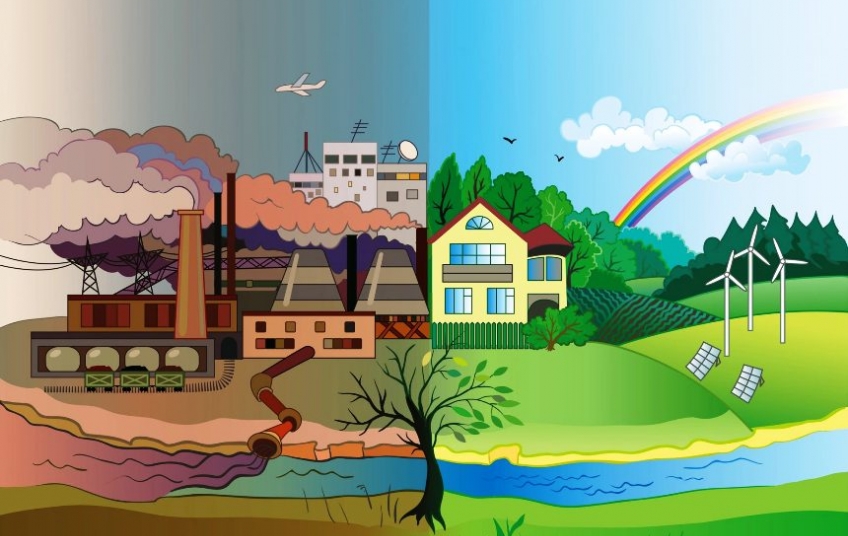Emerging biorefinery industries are looking for solutions to minimize the negative climate impacts typically associated with fossil fuels. The use of biofuels has been condoned by the government, yet they pose issues akin to fossil fuels such as energy inputs and greenhouse effects. Forest product demands and industrial timber harvesting are often cited as the culprits of global deforestation. Is this true? Industrial wood harvesting may not be the cause, leading to the possibility of expanding the use of wood biorefineries. Additionally, synthetic plastics have been produced in the last few decades in petroleum biorefineries for packaging, but due to environmental concerns of waste and emissions, the development of biomass food packaging, particularly in packaging films, has grown in popularity. The processes involved in each biorefinery solution has their pros, cons, and specific role in the industry.
The biorefinery industry has speculated on the use of biofuels, but not without controversy; biofuels are accused of having a large energy cost and carbon footprint comparable to fossil fuels. As energy requirements skyrocket worldwide, biofuels are often seen as a promising alternative to fossil fuels. Governments across the globe have enacted policies in favor of biofuel. However, biofuels are thought to be a threat for food production and conservation due to possible environmental degradation: erosion, the deterioration of soil, and biodiversity. Sustainability assessments alleviate the controversy by “quantifying the economic, environmental, and societal impacts” (Maria, Jenkins) of biofuels. This is done through the life cycle assessment (LCA), a holistic approach to quantifying environmental impact. (Maria, Jenkins)

The wheel-to-wheel perspective looks at biofuels at all stages of the fuel value chain by splitting it into three sections: “feedstock production and supply, fuel production and distribution, and vehicle operation.” (Maria, Jenkins) This perspective allows a fair assessment of different biorefinery fuel types. The well-to-tank (WTT) and cradle-to-gate (CTG) approaches are good at evaluating the cost efficiency of the technologies used to extract each fuel. The wheel-to-wheel greenhouse gas emissions of biofuel to gasoline is shown in the following graph.
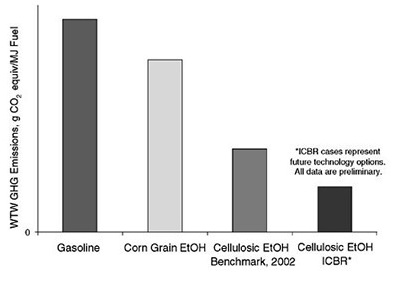
The cradle-to-gate assessment of different biofuel extractions is shown below, demonstrating that some forms of biofuel require much less fossil fuel than ethanol in their production.
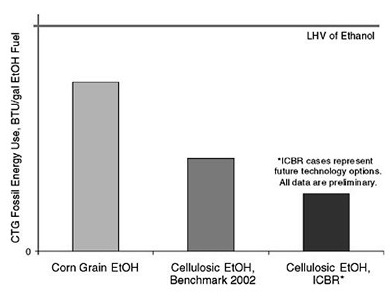
Research on wood biorefineries claims that contrary to popular belief, countries with high-value industrial timber harvest do not suffer from the effects of deforestation; rather, countries that chiefly use wood biomass for non-industrial purposes (fuel and heating) suffer from deforestation. (Thorp) This relationship is shown by the following chart.
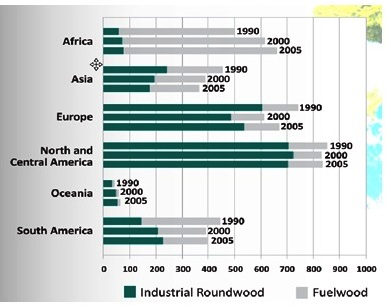
The countries that do not use their forests for high-value timber harvest do not place as great an effort on forest sustainability, leading to deforestation. This is shown by the countries’ use of fuelwood, particularly in Africa and South America. Contrapositive, the countries with a higher emphasis on industrial roundwood, such as Europe and North and Central America, have denser forests. Dispelling the myth of industrial deforestation leads to the possibility of extending sustainable, non-renewable biorefineries. The future of the use of wood biomass in biorefineries is dependent on governmental forest policies, technological development in the field of timber harvesting, and the competition with lower cost energy sources. The successful research and deployment of biomass usage will drive biomass sustainability; this includes the production of cellulose, hemicellulose, lignin and other biomasses formed from cellulosic processes. (Thorp)
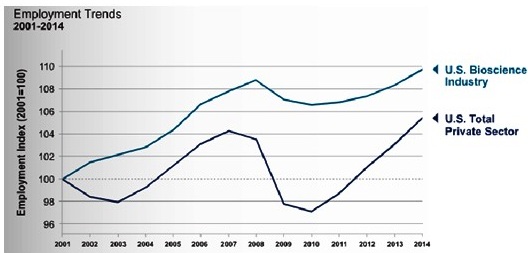
The future of biomass is promising, as the average growth of the U.S. Bioscience Industry from 2001 to 2014 is nearly 80% higher than the aggregate private sector. Moreover, there are other benefits to using biomass in refineries.
People have been using non-synthetic biomaterials for centuries, but within the last few decades, the use of petroleum-based plastics has permeated the biorefinery industry. The cost of creating these synthetic materials is heavy carbon emissions and non-biodegradable waste, raising concerns for the environment and stimulating awareness of polysaccharide and protein macromolecules in packaging. (Woodhead Publishing) Recycling for food packaging is limited by technical and economic difficulties, but this advantage of biodegradable waste products over plastics may disappear. In contrast, the incineration of plastics such as PVC creates toxic compounds - furans and dioxins - which would be released into the environment. What is the solution? Biodegradable materials have been promoted for flexible food packaging, and most proteins and polysaccharides can be used for edible packaging. These edible packaging materials are meant to be quintessential parts of the food, and they can be applied as a coating sealed to the surface or an edible pouch. While this edible packaging is not expected to remove plastic packaging altogether, it can mitigate the effects that petroleum biorefineries have on the environment and extend food stability by reducing moisture exchange. The following image shows how an edible biomass film is created.
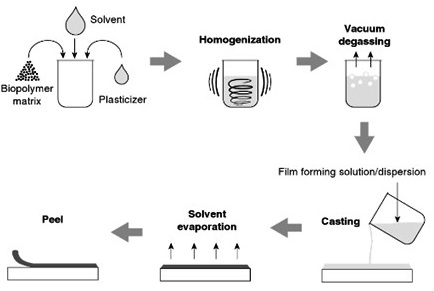
Likewise, these macromolecules have the thermoplastic properties under low moisture condition, allowing them to be used in existing plastic processing techniques and heating the biomass above its glass transition temperature changes them to a rubber state. This is good for packaging films. (Woodhead Publishing)

However, many of these biomass polymers breakdown under processing and thus need to be plasticized (to be made moldable), adding in the need for more expensive thermoforming equipment that is more efficient in large-scale production yet non-cost-effective at small-scale. Additionally, their inherent properties are often inferior to petroleum-based plastics. The future of biomass refineries is dependent on the cost of CO2. An increase in the cost of CO2 would support the widespread transition of biorefineries from fossil fuels to biomass conversion. Until international trade in biomass gains momentum, other biorefinery and packaging solutions should be considered.
The future of biorefineries has several promising alternatives to fossil fuels, including biomasses and biofuels. Biomass conversion means that there will be less reliance on petroleum-based plastics and using the biofuel evaluation techniques discussed can determine the fossil fuel energy inputs required in the processing of each type of biofuel, of which cellulosic materials tend to excel. Reliant on the outcome of governmental decisions and private sector trends, wood based biorefineries may become more prominent. When the cost of CO2 emissions of fossil fuel biorefineries outweighs the cost of its alternatives, harmful greenhouse processes will diminish.
References
Alles, Carina Maria, and Robin Jenkins. “Read ‘Frontiers of Engineering: Reports on Leading-Edge Engineering from the 2007 Symposium’ at NAP.edu.” National Academies Press: OpenBook, DuPont Engineering Research & Technology, 2008, www.nap.edu/read/12027/chapter/15#82.
“Advances in Biorefineries: Biomass and Waste Supply Chain Exploitation.” Edited by Keith W Waldron, Google Books, Woodhead Publishing, 2014, (pg. 819 - 826), http://url.ie/11ysx
Thorp, Ben , et al. “Paper360 - September/October 2017 - A Biorefinery Industry is Emerging.” Home • Nxtbook Media, Paper 360 , 2017, www.nxtbook.com/naylor/PPIS/PPIS0517/index.php?startid=28#/30





























